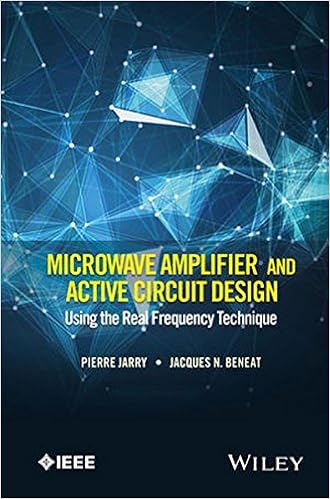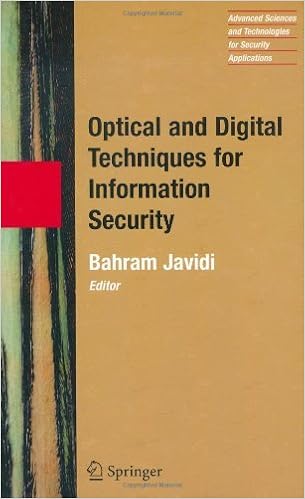Download e-book for kindle: Microwave Amplifier and Active Circuit Design Using the Real by Pierre Jarry

By Pierre Jarry
ISBN-10: 1119073200
ISBN-13: 9781119073208
Describes using the true Frequency procedure for designing and figuring out RF/microwave amplifiers and circuits
This booklet specializes in the authors' actual Frequency method (RFT) and its program to a wide selection of multi-stage microwave amplifiers and energetic filters, and passive equalizers for radar pulse shaping and antenna go back loss purposes. the 1st chapters overview the basics of microwave amplifier layout and supply an outline of the RFT. each one next bankruptcy introduces a brand new form of amplifier or circuit layout, reports its layout difficulties, and explains how the RFT could be tailored to resolve those difficulties. The authors take a pragmatic process by means of summarizing the layout steps and giving a variety of examples of amplifier realizations and measured responses.
- Provides a whole description of the RFT because it is first used to layout multistage lumped amplifiers utilizing a revolutionary optimization of the equalizers, resulting in a small variety of parameters to optimize simultaneously
- Presents variations to the RFT to layout trans-impedance microwave amplifiers which are used for photodiodes appearing as excessive impedance present sources
- Discusses the tools utilizing the RFT to optimize equalizers made up of lossy disbursed networks
- Covers equipment and examples for designing typical linear multi-stage energy amplifiers and people utilizing arborescent structures
- Describes the right way to use the RFT to layout multi?]stage energetic filters
- Shows the flexibleness of the RFT to unravel numerous microwave circuit layout difficulties just like the challenge of passive equalizer layout for Radar receivers
- Examines a potential process for the synthesis of microwave antennas utilizing the RFT
Microwave Amplifier and lively Circuit layout utilizing the genuine Frequency approach is meant for researchers and RF and microwave engineers yet can be appropriate for complicated graduate scholars in circuit design.
Dr. Beneat and Dr. Jarry are individuals of the editorial board of Wiley’s International magazine of RF and Microwave desktop Aided Engineering. they've got released seven books jointly, together with Advanced layout recommendations and Realizations of Microwave and RF Filters (Wiley-IEEE 2008), Design and Realizations of Miniaturized Fractals RF and Microwave Filters (Wiley 2009), Miniaturized Microwave Fractal Filters—M2F2 (Wiley 2012), and RF and Microwave Electromagnetism (Wiley-ISTE 2014).
Read or Download Microwave Amplifier and Active Circuit Design Using the Real Frequency Technique PDF
Best microwaves books
New PDF release: RF imperfections in high-rate wireless systems: impact and
Instant verbal exchange structures are over and over utilizing wider bandwidths, greater sign dynamics and better service frequencies to fulfil the call for for better facts charges. This ends up in an ever expanding call for at the functionality of inexpensive and power-efficient radio frequency (RF) front-ends. because the RF know-how is, accordingly, driven to its operation limitations, the intrinsic imperfections of the RF IC know-how are progressively more governing the method functionality of instant modems.
Download PDF by Bahram Javidi: Optical and digital techniques for information security
Optical and electronic recommendations for info defense is the 1st publication in a sequence targeting complex Sciences and applied sciences for protection Applications.
This ebook encompases the result of learn research and applied sciences used to safe, make sure, realize, music, and authenticate gadgets and knowledge from robbery, counterfeiting, and manipulation through unauthorized individuals and firms. this data safeguard booklet will draw at the different services in optical sciences and engineering, electronic picture processing, imaging structures, details processing, machine dependent info platforms, sensors, detectors, and biometrics to document leading edge applied sciences that may be utilized to details protection issues.
The complex Sciences and applied sciences for safety purposes sequence specializes in learn monographs within the parts of:
* acceptance and id (including optical imaging, biometrics, authentication, verification, and shrewdpermanent surveillance systems)
* organic and chemical chance detection (including biosensors, aerosols, fabrics detection and forensics)
* safe details platforms (including encryption, and optical and photonic systems).
The sequence is meant to offer an summary on the hightest study point on the frontier of study within the actual sciences.
Dikshitulu K. Kalluri's Electromagnetics of Time Varying Complex Media: Frequency PDF
Thoroughly revised and up to date to mirror fresh advances within the fields of fabrics technology and electromagnetics, Electromagnetics of Time various advanced Media, moment variation offers a complete exam of present issues of curiosity within the examine community—including concept, numerical simulation, software, and experimental paintings.
This booklet covers complex subject matters in dynamic modeling of soil-foundation interplay, in addition to the reaction of elastic semi-infinite media from an functions point of view. complex suggestions comparable to options for research of elastic semi-infinite mediums, fluid movement in porous media, and nonlinearities in dynamic habit are defined in nice element.
- 60-GHz CMOS Phase-Locked Loops
- Lab-on-Fiber Technology
- Microstrip Lines and Slotlines
- Digital Timing Measurements
- Computational Methods for Electromagnetic and Optical Systems, Second Edition
- Low Power RF Circuit Design in Standard CMOS Technology
Extra resources for Microwave Amplifier and Active Circuit Design Using the Real Frequency Technique
Example text
The design of an equalizer involves the use of an optimization process based on the Levenberg– Marquardt–More optimization technique and optimizing a single equalizer at a given time makes for very efficient optimization. 3. Z0 is the reference used for the scattering parameters. 3 Transducer gain for k equalizer–transistor stages terminated on Z0. 4 Transducer gain for the first stage terminated on Z0. 4. The transducer gain of the first stage is given by T1 = 1 − ρG 2 e21, 1 2 S21, 1 2 1 − e11, 1 SG, 1 2 1 − e22, 1 S11, 1 2 2 18 Introduction to the Real Frequency Technique 43 with e22, 1 = e22, 1 + e221, 1 SG, 1 1 − e11, 1 SG, 1 SG, 1 = ρG ρG = ZG − Z0 ZG + Z0 2 19 2 20 2 21 where SG,1 would be the output reflection coefficient of a transistor 0, but since there is no transistor 0, it is equal to the reflection coefficient of the source ρG ê22,1 is the output reflection of equalizer 1 when loaded on input ρG is the reflection coefficient of the source impedance ZG The transducer gain equations are demonstrated in Appendix A.
The transducer gain of the first stage is given by T1 = 1 − ρG 2 e21, 1 2 S21, 1 2 1 − e11, 1 SG, 1 2 1 − e22, 1 S11, 1 2 2 18 Introduction to the Real Frequency Technique 43 with e22, 1 = e22, 1 + e221, 1 SG, 1 1 − e11, 1 SG, 1 SG, 1 = ρG ρG = ZG − Z0 ZG + Z0 2 19 2 20 2 21 where SG,1 would be the output reflection coefficient of a transistor 0, but since there is no transistor 0, it is equal to the reflection coefficient of the source ρG ê22,1 is the output reflection of equalizer 1 when loaded on input ρG is the reflection coefficient of the source impedance ZG The transducer gain equations are demonstrated in Appendix A.
8. 2 Levenberg–Marquardt–More Optimization This algorithm is used to define n unknown parameters that minimize a single-valued error function E(X) made of a sum of squares: 2 m ei X E X = with ei X = i=1 factual ωi ,X − 1 and X = ftarget ωi x1 x2 2 33 xn where X is the parameter vector made of the n parameters to optimize. By defining e(X) as the error vector made of the m single errors between actual and target functions at the m frequencies e T X = e1 ω1 , X , e2 ω2 ,X , e3 ω3 , X , …, em ωm , X 2 34 The single-valued error function E(X) can be written as the norm squared of the error vector e(X): E X = eT X e X = e X 2 In order to minimize the single-valued error function E(X), the gradient of E(X) is a useful quantity and is defined as ∇E X = ∇ where J is the Jacobian matrix defined by eX 2 = 2J T e X Introduction to the Real Frequency Technique 47 ∂e1 X ∂x1 ∂e1 X ∂x2 ∂e1 X ∂xn ∂e2 X ∂x1 ∂e2 X ∂x2 ∂e2 X ∂xn ∂e3 X ∂x1 J= ∂e4 X ∂x1 ∂e3 X ∂x2 ∂e3 X ∂xn ∂e4 X ∂x2 ∂e4 X ∂xn ∂em X ∂x1 ∂em X ∂x2 ∂em X ∂xn 2 35 For a slight displacement vector ΔX in the parameter vector X, the error vector at X + ΔX can be approximated using a first-order Taylor series such that e X + ΔX ≈e X + JΔX The gradient of the single-valued error function at X + ΔX can then be approximated using ∇E X + ΔX = ∇ e X + ΔX 2 = 2J T e X + ΔX ≈2J T e X + JΔX To define the n unknown parameters, the single-valued error function E(X) is minimized using an iterative method based on making the gradient ∇E X + ΔX equal to 0.
Microwave Amplifier and Active Circuit Design Using the Real Frequency Technique by Pierre Jarry
by Paul
4.3



